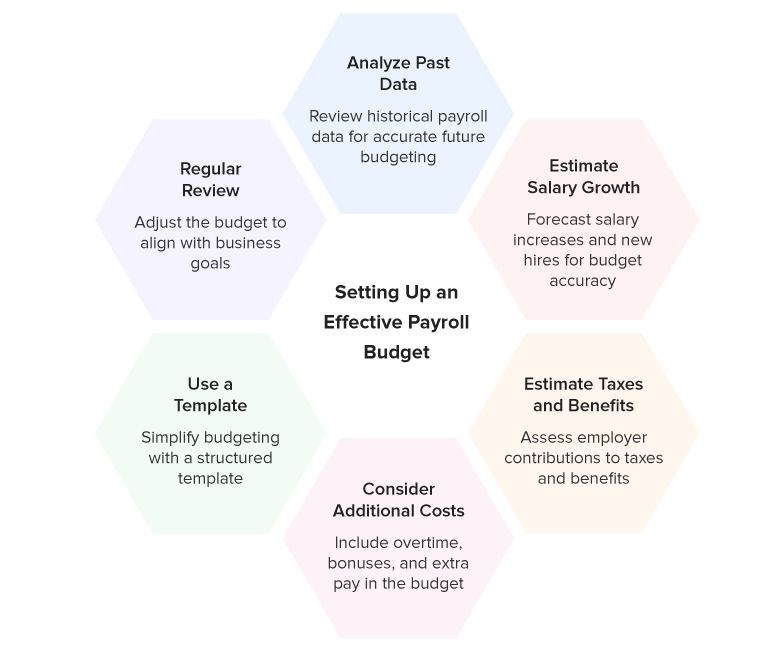Payroll Budget in India with Effective Strategies 2025

Table of Contents
An effective payroll budget can make or break a business, particularly within India’s complex regulatory environment. Managing payroll is one of the most vital responsibilities for any organization, especially in India, where strict compliance with labor laws is important. Effective payroll budgeting plays a key role in helping organizations meet their financial obligations while maintaining operational efficiency.
Developing a budget for payroll provides a clear estimate of employee costs for the year ahead. Payroll costs usually represent a considerable portion of a company’s budget, whether it’s a small business with a few employees or a Fortune 500 enterprise.
Preparing a payroll budget involves a detailed study of employees’ Cost to Company (CTC) and other expenses. A carefully planned payroll budget helps control HR costs, maintains compliance, and enables informed decision-making that supports long-term growth.

What is a Payroll Budget?
A payroll budget is a financial plan that forecasts the total estimated cost of compensating employees for a specific period, typically a month, quarter, or year, encompassing wages, benefits, and taxes, and helps businesses manage and control labor expenses.
Payroll compliance is a critical legal requirement for businesses operating in India. The payroll budget must comply with all government regulations on time. Using payroll software in India helps avoid errors. HR effectively tracks payments and taxes using payroll automation tools.
The HR department should regularly update payroll strategies to account for changing costs and laws. Payroll software in India offers reports that simplify monthly planning. Automated systems reduce manual work and significantly lower payroll costs. A smart payroll budget ensures that employees are paid on time and correctly.
Payroll budgeting helps HR professionals stay compliant, avoid penalties, and forecast future financial requirements. It also supports smooth audits and builds trust among all stakeholders.
Understanding Payroll Budget in India
Payroll budgeting in India refers to the planning of employee salaries, benefits, and statutory obligations. It also includes allowances, PF, ESI, and tax deductions. HR teams must align payroll budgets with statutory requirements to ensure compliance with labor laws and regulatory standards.
HR teams must regularly track payroll expenses to manage overall business costs effectively. Payroll software in India simplifies budgeting and ensures error-free processing. The payroll software helps HR professionals by automating accurate calculations and ensuring on-time salary disbursements.
Payroll strategies should prioritize cost efficiency and employee needs. A clear payroll budget accurately projects these expenses, enabling the company to meet its financial responsibilities without overspending. Strategic payroll planning enables HR professionals to plan for sustainable business growth.
HR must check the budget every three months and update it as needed. Implementing innovative payroll plans enables HR to utilize resources more effectively.

Key Factors Impacting Payroll Costs in India
Statutory Contributions
Statutory contributions have a considerable effect on the total payroll expense. Organizations are responsible for thoroughly managing PF, ESI, gratuity, and professional tax compliance. These contributions are very essential for payroll compliance with Indian laws.
Delays or mistakes may result in penalties and damage to the company’s reputation. Payroll software in India helps ensure the timely compensation of the workforce and maintains accurate legal records for audit purposes.
Salary Structure
The salary structure impacts payroll expenses and budget. HR needs to thoughtfully align fixed salaries, allowances, and performance-based rewards to build a balanced compensation framework.
Payroll software simplifies salary calculations and improves accuracy. Understanding how payroll is calculated supports more accurate budgeting and financial control. A clear salary structure ensures fair pay and builds employee trust.
Employee Classification
Employee classification refers to the way an organization categorizes its workforce, which directly influences compensation, benefits, and legal responsibilities. Common categories include full-time, part-time, contract, independent contractor, temporary, and intern.
Payroll software in India helps HR manage roles with fewer mistakes. Proper employee grouping requires a thorough knowledge of payroll compliance regulations set by both the central and state governments. Proper grouping is vital to ensure adherence to labor laws and to avoid potential legal disputes.
Regional and Industry-Specific Regulations
Localized and sector-specific legal frameworks are designed to address unique regional or industry needs. Territorial regulations govern business activities within specific areas, ensuring compliance with local laws and standards.
Regulations tailored to specific industries address the unique compliance and operational demands of those sectors, for example, HIPAA for healthcare and PCI DSS for the financial sector. These regulations help maintain legal compliance, safety, and integrity across diverse operational environments.
HR professionals need to understand how these regulations affect payroll tax and income tax to plan effectively and avoid risks.
Impact of Recent Union Budget Reforms on Payroll (Tax Slabs, TDS/TCS Updates)
The Union Budget changed tax slabs, affecting payroll costs. HR must update payroll budgeting to reflect the new TDS and TCS rules. These changes affect payroll compliance and salary calculations for every business in India. Using payroll software simplifies accurate tax deductions and ensures timely, compliant filings.
Knowing how to optimize the payroll process helps an organization handle changes effectively. Payroll strategies in India need regular updates to reduce mistakes and risks. Regular evaluation allows HR professionals to control payroll costs and ensure compliance effectively.

Setting up an Effective Payroll Budget
Creating an effective payroll budget involves analyzing past payroll information, anticipating future expenses, and including all relevant taxes and employee benefits. Regularly review and update the budget to keep it aligned with the changing workforce and evolving organizational requirements.
Main factors to consider for preparing an effective payroll budget:

- Analyze past payroll data: Review past payroll data—including salaries, taxes, and benefits—to create a foundation for accurate future budgeting.
- Estimate salary and compensation growth: Account for anticipated salary increases, role-based promotions, and potential new hires to ensure accurate forecasting.
- Estimate payroll taxes and employer-paid benefits: Accurately assess the employer’s contributions toward taxes (such as Social Security, Medicare, and unemployment) along with employee benefits like health insurance and retirement contributions.
- Consider additional costs: Includes overtime, bonuses, and any other extra pay obligations when budgeting payroll.
- Use a payroll budget template: Use a template to simplify budgeting, ensuring the incorporation of all key components and maintaining calculation accuracy.
- Regularly review and align your payroll budget: Compare actual spending to the budget regularly and adjust as needed to ensure financial stability and compliance while keeping your payroll strategy aligned with overall business goals.
- Include miscellaneous payroll expenses: Remember to include other payroll-related costs like recruitment, employee training programs, and engagement activities; these costs can add up significantly over time, so be sure to budget for them accordingly.
Best Practices for Payroll Budgeting in India
Payroll budgeting in India requires thorough financial planning and compliance with complex regulatory frameworks. The following best practices can help ensure accuracy, efficiency, and legal adherence:
- Monitor changes in Indian labor laws: Regulations around EPF, ESI, and income tax are regularly updated. Staying informed is essential to ensure ongoing compliance and avoid penalties.
- Implement Payroll Technology: Implementing payroll software automates complex calculations, reduces mistakes, improves efficiency, and ensures compliance with tax laws and regulatory requirements.
- Maintain transparent communication with employees: Provide a clear breakdown of salary components, benefits, incentives, and tax deductions. Transparency in payroll builds trust and contributes to higher employee engagement and retention.
- Compare Actual Payroll Expenses to Budget: Regularly compare real payroll expenditures against the projected budget to identify discrepancies and make adjustments to the financial plan.
- Plan for Future Growth: While planning, consider requirements to recruit more employees or scale business operations. This proactive approach helps to forecast upcoming payroll costs more accurately.

Conclusion
Payroll budgeting is important for Indian businesses. It helps control expenses and follow the rules. It helps ensure employees are paid on time, contributing to higher satisfaction levels. HR teams should use payroll software to automate and streamline their work processes. Regularly monitoring payroll plans helps prevent problems and maintain a stable budget.
Following trusted guides, such as the comprehensive payroll guide, helps HR professionals manage payroll and maintain compliance. It helps organizations make wise choices and grow successfully. Using payroll automation can save HR teams time and reduce payroll costs.
FAQs
What are the Latest Updates in Indian Payroll Laws for 2025 and Their Impact on Budgets?
India’s new payroll rules have increased tax exemption limits and updated labor laws to fit employees’ needs today. These changes not only make it easier for businesses to follow the rules but also help employees earn a larger portion of their salary. Because of this, employers should revise their payroll budgets to keep everything in sync with the latest regulations. Staying informed in this way helps HR teams handle costs and compliance smoothly without unnecessary headaches.
What Strategies Help Optimize Employee Benefits while Maintaining Statutory Compliance in India?
To optimize benefits, HR should strike a balance between attractive perks and legal requirements. Using payroll software helps track benefits and compliance easily. Regular audits ensure all statutory requirements are followed. Clear communication with employees about benefits also builds trust. These steps help control costs and maintain strong payroll compliance.
Grow your business with factoHR today
Focus on the significant decision-making tasks, transfer all your common repetitive HR tasks to factoHR and see the things falling into their place.

© 2025 Copyright factoHR


